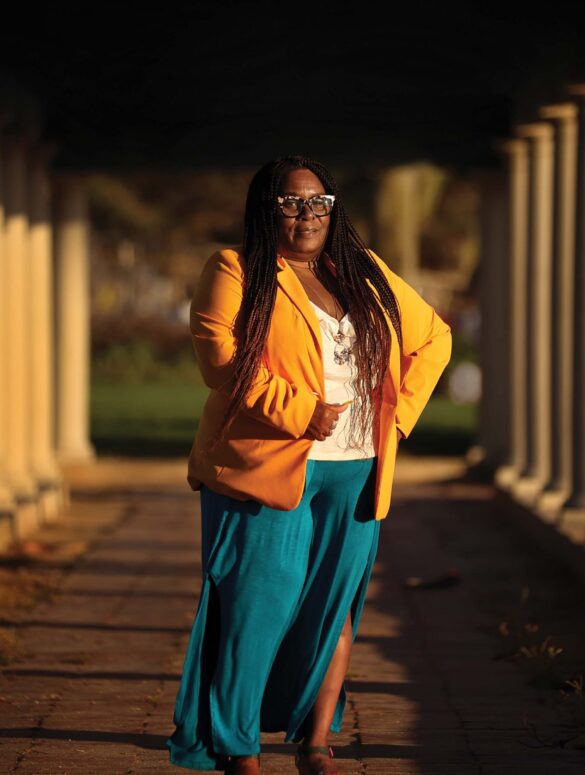Text by Marah Eakin
Images by Rick Loomis and courtesy Santa Monica History Museum
Santa Monica, with its iconic pier, pristine beaches, and vibrant culture, often conjures images of sun-soaked surfing and leisurely strolls on the boardwalk. Yet, beyond the well-trodden tourist paths and beachfront merriment, there’s a deeper history that often remains obscured. It’s a history that is as fascinating as it is significant—the history of Black Santa Monica.
Santa Monica is believed to be home to the first African American settlement in any seaside community in California. As the 20th century dawned, Black pioneers migrated from the Jim Crow South, seeking a fresh start in the sun-kissed coastal town. However, they soon encountered familiar obstacles—prejudice and de facto segregation. While the sun, sand, and surf beckoned, access was limited to Bay Street Beach, known as “The Inkwell,” a two-block stretch of shoreline just south of the iconic Pier.

It’s a history Robbie Jones, founder of Black Santa Monica Tours, is determined to tell. “Our parents and grandparents didn’t always talk about these stories, because that history was painful,” Jones says, walking the streets of the town she’s lived in some 60-plus years. “Even people who lived here were like ‘There’s nothing [historical] here.’ I knew that the history was interesting, though, and that people needed and wanted to know.”
That want is being satisfied by several in the community.
Alison Rose Jefferson, a historian with a PhD, has dedicated herself to researching and documenting the history of Black Santa Monica. Her comprehensive 155-page essay, “Reconstruction and Reclamation: The Erased African American Experience in Santa Monica History,” developed for the Belmar History + Art project, and supported by the City of Santa Monica, delves into the early years of the 20th century. It vividly recounts the arrival of African Americans, the establishment of storefronts, and the development of neighborhoods.
The Quinn Research Center (QRC), led by its Director, Carolyne Edwards, shares the responsibility of preserving this vital history. The QRC’s mission is to empower the community by promoting the study and research of Black family history and culture in the Santa Monica Bay area. Named after Dr. Alfred T. Quinn, the First African American School Teacher in the Santa Monica-Malibu Unified School District, the center boasts a treasure trove of documents and photographs left behind by Dr. Quinn. These valuable historical artifacts are now accessible to all through an online archive at Quinnresearchcenter.com.

There, the names of Santa Monica’s African American pioneers and their contributions come back to life. Names like Lloyd Allen, one of the first African American small business owners, who would later become the Recreation and Parks Director. Marcus O. Tucker Jr., the first African American presiding Judge at the Long Beach Municipal Court, whose father was also the first African American Doctor in Santa Monica. Hillard C. Lawson, the first African American Councilmember in the City of Santa Monica. Betty McCleary, one of the first African American “Rosie the Riveters” who supervised plane production during World War II. And Vernon Brunson, an architect who designed numerous homes in the Pico neighborhood, with his son, Donald, the first African baby born in Santa Monica in 1907.
“All of these names and all of these wonderful people have helped shape our community,” says Edwards on TikTok, making the past accessible to a tech-savvy generation.
The revival of Black Santa Monica’s history extends to other modern technology, as well. Snapchat, in collaboration with the Santa Monica History Museum and QRC, introduced the exhibition “Broadway to Freeway: Life and Times of a Vibrant Community” in June 2023. Users of Snapchat can walk through the historic Broadway corridor and explore history through the app’s “Broadway History Lens.” This innovative approach allows users to experience the sights and sounds of a vibrant community of color that once thrived before the construction of the 10 freeway in the 1960s.
Santa Monica Mayor Gleam Davis highlights the importance of preserving these stories. “So many of our marginalized communities are having their history erased, and what we want to do is avoid that,” she said in a video promoting the launch of the project. “Different groups have different stories to tell, and I think sharing all of those stories will make it easier for us all moving forward.”


For those who prefer a more personal touch, Jones continues to be the torchbearer for the cause in person.
Jones started Black Santa Monica Tours in 2004, following her grandmother’s passing. Her family home on 20th Street was a backdrop for countless stories, sparking her mission to share the history of Black Santa Monica with a wider audience. She wanted to ensure the legacy would live on for generations to come, not just through occasional family reunions or friendly requests but for anyone interested in the city’s African American history.
Jones estimates she has taken “thousands” of people on tours, revealing sites of immense cultural significance. She guides visitors through the Virginia Avenue Park, where the community still gathers today, and to “The Inkwell,” where, from 1905 to 1964, Black visitors found their only piece of shoreline.
On her tours, Jones passionately narrates the stories of her own experiences in the city, determined to connect the dots and share a narrative of unity. “I want people to understand that we’re all on this planet together. We need to know everyone’s story,” she says. Her work with local organizations, including the Philomathean Charity Club and the Committee For Racial Justice, highlights her commitment to community and history.
Jones’s next chapter unfolds in 2024 when she opens the Just Family Cafe And Coffee Bar. The café will serve her grandmother’s recipes, showcase local history on its walls, and offer QR codes on tables to provide patrons with an interactive history experience. It will be a hub for community groups, book clubs, and a place where the past and present of Santa Monica intersect.


The cafe will be situated on the first floor of Brunson Terrace, a new affordable-housing development named after Santa Monica’s first recorded Black residents, Charles and Serena Brunson, who raised their two sons, Donald and Vernon, in the city.
The legacy of Vernon Brunson, the architectural designer, poet, and electromechanical designer for Hughes Aircraft, is celebrated in an exhibit at the Quinn Gallery, where Vernon’s influence on contemporary Black architects shines through.
As Jones aptly states, “We’ve come a long way, but there’s still a lot of room to grow.”
If you’re eager to delve into Black Santa Monica’s history, you can book a spot on a Black Santa Monica Tour through blacksantamonicatours.com. It’s an opportunity to explore the hidden treasures of Santa Monica’s vibrant past and join the growing movement to ensure these stories live on for future generations.


